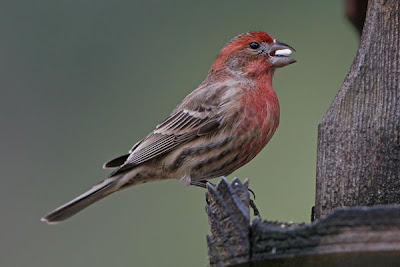Two species that can often cause identification problems at your bird feeders are the ubiquitous House Finch, and the less common Purple Finch. Size wise they are similar, though a Purple Finch may look a little bulkier.
Start by learning the expected species - in this case, for most of us, it would be the House Finch. Female House Finches (
above) are a gray-brown color above with blurry streaks on the breast and underparts, that are about the same color as the birds back. It always reminds me of being an overall dingy color.
By contrast the female Purple Finches in the east (above) are browner and have a bold white supercillium and white whisker or malar. The streaks on the breast tend to be bolder, and stand out against a white underbelly. The similar looking female House Finch lacks the supercillium and is rarely white below, and overall lacks the contrast that female Purple Finches show.
The male House Finch (
above) with its streaking resembles the female House Finch, but has a red or red-orange head and chest, usually brightest on the forehead. You will also notice on this bird that the undertail is streak - a characteristic of House Finches, and which is unmarked in Purple Finches.
Though this illustration of a male Purple Finch (
above) may not be the best, it does clearly show some of the differences between the two species. The color has more of a raspberry tone which can also is found on its back. The underbelly is unstreaked, and as with the female, the auriculars behind the eye are dark and contrast with the rest of the head. One other point worth mentioning is that the tip of the tail on a Purple Finch is distinctively notched (V-shaped), whereas on a House Finch it is only slightly notched.
all photos © adrian binns




































